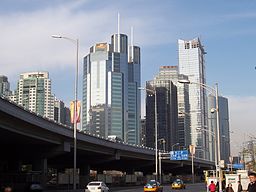 The New York Times headline Sunday “In China, ‘Once the Village is Gone, The Culture is Gone’” certainly grabbed my attention for its construction of “China” and “culture”. The article and accompanying video decry the loss of villages across China due to urbanization. While many migrate for jobs, some are forced to leave their village due to development plans. Since the state owns the land, the government can force people to move to make room for proposed developments, a golf course in this example.
The New York Times headline Sunday “In China, ‘Once the Village is Gone, The Culture is Gone’” certainly grabbed my attention for its construction of “China” and “culture”. The article and accompanying video decry the loss of villages across China due to urbanization. While many migrate for jobs, some are forced to leave their village due to development plans. Since the state owns the land, the government can force people to move to make room for proposed developments, a golf course in this example.
These forced migrations, and the potential for corruption in that process, becomes a site for competing essentialisms. The government officials characterize the move to the urban area, with compensation for the villagers, as promoting “modernization and economic growth.” The image of backward villages corresponds to the negative connotation, according to the article, of the label “farmer” and the assumptions of some that elite, not rural, traditions represent Chinese culture. Some of those forced to migrate, however, emphasize the loss of relationships and “culture” because communities become separated after migration. In their construction, the village, and the traditional practices there, represent Chinese culture.
Both of these essentializing characterizations, of course, are particularly strategic. Projecting an image of a modernizing, urban China fits the agenda of urban planning governmental agencies, while characterizing the village as the repository of traditional Chinese culture valorizes the importance of the villagers. One of the main contributors to the story is from a leading family of that village, where his family rented out rooms to travelers in their spacious home. As he continues to lead the musical group whose repertoire of traditional songs specific to that village represent his construction of Chinese culture being lost, he has received some support through a government registry of intangible cultural heritage and the Ford Foundation, with limited success.
And the article’s author has his own constructions. Referencing village life as “the bedrock of Chinese culture,” the author valorizes the village practices and maintains a nostalgic, romanticized view of unchanging village culture. Would the author, or perhaps the readers, be interested in living in a “traditional” Chinese village, especially if not a member of a leading family in the village? How many of the readers would prefer to spend their time on the golf course that the village was razed to build (though it has not been built yet)?
So, the different characterizations of China, of culture, of village life, all serve a variety of interests in the negotiation of social prestige and access to resources. The same action can be celebrated as advancement, development and reform or denounced as corruption, destruction, and a global loss. The characterizations and the strategic essentialisms that they represent are not innocent descriptions but reflect the ideology, assumptions, and interests of the person making the characterization. Societies are more complex than a simple characterization allows.
Photo of Beijing by 螺钉 (Own work) [CC-BY-SA-3.0 (http://creativecommons.org/licenses/by-sa/3.0)], via Wikimedia Commons
